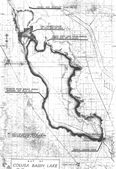 I have another topic that I have had rolling around in my head for a while now, that I want to get out. It ties together water, habitat and the natural cycle of the valley. This topic started with an “aha moment” after seeing the map that has been posted with this blog. It is a map of the Colusa Basin Lake that covered some of the area I currently farm, and currently referred to as Reclamation District 108. It is based on land surveys completed from 1850 -1870 detailing the boundaries of the lake at different times of the year.
I have another topic that I have had rolling around in my head for a while now, that I want to get out. It ties together water, habitat and the natural cycle of the valley. This topic started with an “aha moment” after seeing the map that has been posted with this blog. It is a map of the Colusa Basin Lake that covered some of the area I currently farm, and currently referred to as Reclamation District 108. It is based on land surveys completed from 1850 -1870 detailing the boundaries of the lake at different times of the year.My understanding of the map came from many people who have been farming in the RD 108 area a far longer time than I have. What would happen before all the dams were built is that the whole Colusa Basin Lake would flood in the spring from the spring rains and snowmelt flowing unimpeded from the vast Sacramento River Watershed. The lake, more like a marsh because the area is so flat and shallow, would be at its largest in May and would recede from there. Driven back by the heat and draining back into the river the lake would eventually dry up in September and October until it was replenished the following spring. It was much the same way throughout the Sacramento Valley, not just in RD 108. That’s how it was.
Fast forward 150 years and the lake no longer floods in the springtime because of the levees along the river and our bypass flood control system, and because we now have Shasta Dam and Oroville Dam to hold back most of the water to deliver to farms and cities when it is needed instead of all at once. Relieving us from the dangers of flooding, and of a yearly late fall drought when the rivers would slow to a trickle or dry up entirely.
My point is this: rice farming in the valley does seem to follow the natural cycle of the valley, historically. We plant the fields in April and May when the lakes/marshes would be at their greatest extent. Throughout the summer we raise the rice, and when the lakes/marshes would eventually recede or dry up in September and October, we drain our fields and harvest our crop. As the winter rains come, the cycle begins again. It isn’t like it was in the 1860s, but it’s not far off either. That’s all I’m saying.
What do you, the readers, think?

No comments:
Post a Comment